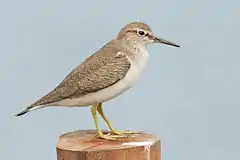| Actitis[1] | |||
| Illiger, 1811[2] | |||
 Przedstawiciel rodzaju – brodziec piskliwy (A. hypoleucos) | |||
| Systematyka | |||
| Domena | |||
|---|---|---|---|
| Królestwo | |||
| Typ | |||
| Podtyp | |||
| Gromada | |||
| Podgromada | |||
| Infragromada | |||
| Rząd | |||
| Podrząd | |||
| Parvordo | |||
| Nadrodzina | |||
| Rodzina | |||
| Podrodzina | |||
| Plemię | |||
| Rodzaj |
Actitis | ||
| Typ nomenklatoryczny | |||
|
Tringa hypoleucos Linnaeus, 1758 | |||
| Synonimy | |||
|
| |||
| Gatunki | |||
| |||
Actitis – rodzaj ptaków z podrodziny brodźców (Tringinae) w rodzinie bekasowatych (Scolopacidae).
Zasięg występowania
Rodzaj obejmuje gatunki występujące w Eurazji i Ameryce Północnej, zimą także w Afryce, Australazji i Ameryce Południowej[8].
Morfologia
Długość ciała 18–21 cm, rozpiętość skrzydeł 37–41 cm; masa ciała 19–93 g; samice są średnio nieco większe i cięższe od samców[8].
Systematyka
Etymologia
- Actitis (Atites, Actitus): gr. ακτιτης aktitēs „mieszkaniec wybrzeża”, od ακτη aktē, ακτης aktēs „wybrzeże”; ιζω izō „siedzieć”[9].
- Tringoides (Trygoides, Tryngodes): rodzaj Tringa Linnaeus, 1758 (brodziec); gr. -οιδης -oidēs „przypominający”[10]. Gatunek typowy: Tringa macularia Linnaeus, 1766.
- Guinetta: wł. nazwa Grinetta dla jakiegoś małego ptaka wodnego, na przykład bekasa lub kureczki[11]. Gatunek typowy: Tringa hypoleucos Linnaeus, 1758.
Podział systematyczny
Do rodzaju należą następujące gatunki[12]:
- Actitis hypoleucos (Linnaeus, 1758) – brodziec piskliwy
- Actitis macularius (Linnaeus, 1766) – brodziec plamisty
Uwagi
Przypisy
- ↑ Actitis, [w:] Integrated Taxonomic Information System (ang.).
- ↑ J.K.W. Illiger: Prodromus systematis mammalium et avium additis terminis zoographicis utriusque classis, eorumque versione germanica. Berolini: sumptibus C. Salfeld, 1811, s. 262. (łac.).
- ↑ Ch.L. Bonaparte. The Genera of North American Birds, and a Synopsis of the Species found within the territory of the United States; systematically arranged in Orders and Families. „Annals of the Lyceum of Natural History of New York”. 2, s. 326, 1828. (ang.).
- ↑ E. Griffith: The fifth order of birds, waders, Grallae, Lin. Echassiers, Cuv.. W: G. Cuvier: The animal kingdom: arranged in conformity with its organization. Cz. 8: Aves. London: Printed for G.B. Whittaker, 1829, s. 391. (ang.).
- ↑ T.B.L. Baker: An ornithological index, arranged according to the synopsis avium of Mr. Vigors. London: Printed by R. Taylor, 1835, s. 145. (ang.).
- ↑ G.R. Gray: A list of the genera of birds: with their synonyma an indication of the typical species of each genus. London: R. and J.E. Taylor, 1840, s. 68. (ang.).
- 1 2 F. Heine & A. Reichenow: Nomenclator Musei Heineani Ornithologici; Verzeichniss der Vogel-Sammlung des Kgl. Oberamtmanns Ferdinand Heine. Berlin: R. Friedländer & Sohn, 1882–1890, s. 326. (niem.).
- 1 2 T. Piersma, J. van Gils & P. Wiersma: Family Scolopacidae (Sandpipers, Snipes and Phalaropes). W: J. del Hoyo, A. Elliott & J. Sargatal: Handbook of the Birds of the World. Cz. 3: Hoatzin to Auks. Barcelona: Lynx Edicions, 1996, s. 513. ISBN 84-87334-20-2. (ang.).
- ↑ Actitis, [w:] The Key to Scientific Names, J.A. Jobling (red.), [w:] Birds of the World, S.M. Billerman et al. (red.), Cornell Lab of Ornithology, Ithaca [dostęp 2022-02-01] (ang.).
- ↑ Tringoides, [w:] The Key to Scientific Names, J.A. Jobling (red.), [w:] Birds of the World, S.M. Billerman et al. (red.), Cornell Lab of Ornithology, Ithaca [dostęp 2022-02-01] (ang.).
- ↑ Guinetta, [w:] The Key to Scientific Names, J.A. Jobling (red.), [w:] Birds of the World, S.M. Billerman et al. (red.), Cornell Lab of Ornithology, Ithaca [dostęp 2022-02-01] (ang.).
- ↑ Systematyka i nazwy polskie za: P. Mielczarek & M. Kuziemko: Plemię: Tringini Rafinesque, 1815 (Wersja: 2020-01-12). [w:] Kompletna lista ptaków świata [on-line]. Instytut Nauk o Środowisku Uniwersytetu Jagiellońskiego. [dostęp 2020-01-31].
This article is issued from Wikipedia. The text is licensed under Creative Commons - Attribution - Sharealike. Additional terms may apply for the media files.